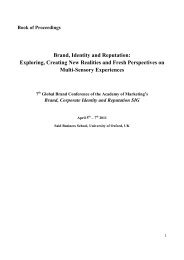PDF (24 Pages)
PDF (24 Pages)
PDF (24 Pages)
You also want an ePaper? Increase the reach of your titles
YUMPU automatically turns print PDFs into web optimized ePapers that Google loves.
Table 2.1 : Gripper classification according to their physical principle of operation<br />
(Gareth J. Monkman et al, 2007)<br />
Prehension<br />
method Gripper type Typical object materials<br />
Impactive<br />
Rigid objects<br />
Ingresive Intrusive Flexible Objects : textiles, carbon and glass fibre<br />
Non-intrusive<br />
Vacuum suction<br />
Flexible Objects : textiles, carbon and glass fibre<br />
Non-porous, rigid materials<br />
Astrictive Magnetoadhesion Ferrous materials<br />
Electroadhesion<br />
Thermal<br />
Light sheet materials and microcomponents<br />
Flexible Objects : textiles, carbon and glass fibre<br />
Contigutive Chemical Carbon fibre with glue impregnation<br />
Fluid<br />
Small, light objects (microcomponents)<br />
Table 2.2 : Gripper classification and suitability of object materials (Gareth J. Monkman<br />
et al, 2007)<br />
Prehension<br />
method Gripper type Typical examples<br />
Impactive<br />
Clamps (external fingers, internal fingers, chucks,<br />
spring clamps), tongs (parallel, shear, angle,<br />
radial)<br />
Ingresive Intrusive Pins, needles, hackles<br />
Non-intrusive<br />
Vacuum suction<br />
Hook and loop<br />
Vacuum suction cup/ bellows<br />
Astrictive Magnetoadhesion Permanent magnet, electromagnet<br />
Electroadhesion<br />
Thermal<br />
Electrostatic field<br />
Freezing, melting<br />
Contigutive Chemical Permatack adhesives<br />
Fluid<br />
Capillary action, surface tension<br />
7
















